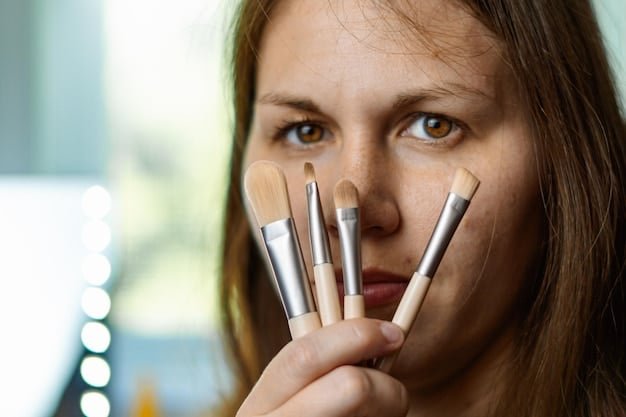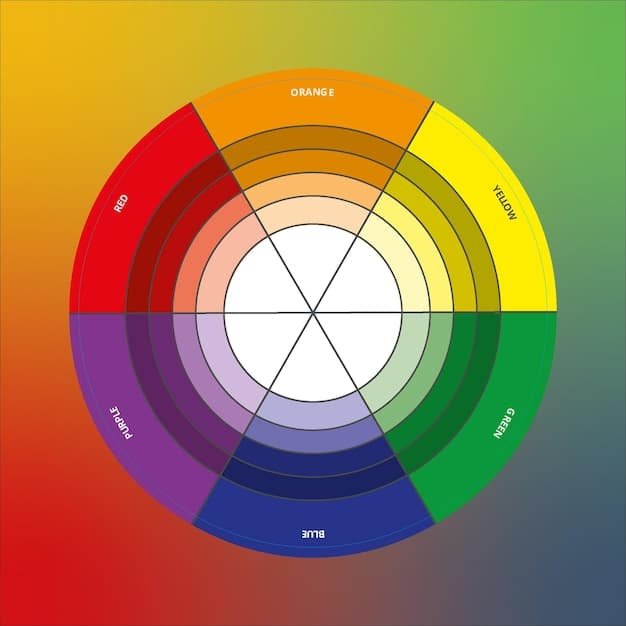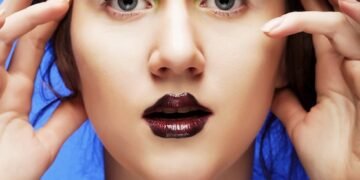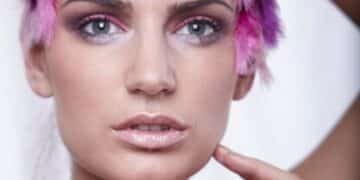Concealer 101: Your Guide to Color Correction in the US

Concealer 101: Mastering Color Correction for Dark Circles and Blemishes in the US offers a comprehensive guide to understanding and using concealers to effectively address skin imperfections–we delve into types, techniques, and tips tailored for flawless face makeup, creating the perfect base for any look.
Embark on a journey to flawless skin with Concealer 101: Mastering Color Correction for Dark Circles and Blemishes in the US. Discover the secrets to using concealers effectively to camouflage imperfections and achieve a radiant complexion.
Understanding Concealer Types and Formulations
Concealers are not one-size-fits-all. Knowing the different types and formulations available can make a significant difference in achieving your desired look.
From liquid to cream to stick concealers, each type has its strengths and is suited for different skin types and concerns.
Liquid Concealers: Versatility at Its Best
Liquid concealers are a popular choice due to their lightweight texture and versatile coverage.
Cream Concealers: Rich and Hydrating
Cream concealers offer more coverage than liquid concealers and are ideal for dry or mature skin.
- Liquid Concealers: Best for oily or combination skin and for light to medium coverage.
- Cream Concealers: Excellent for dry skin and providing full coverage.
- Stick Concealers: Ideal for spot concealing and on-the-go touch-ups.
Understanding the various types ensures you select a product suitable for your specific needs, enhancing your overall makeup application.
Color Correction: Neutralizing Imperfections
Color correction involves using concealers with specific hues to neutralize unwanted colors on the skin, such as redness or dark circles.
By understanding the color wheel and how different colors interact, you can effectively address various skin concerns.

The Color Wheel: A Quick Guide
The color wheel is your best friend when it comes to color correcting. Colors opposite each other on the wheel neutralize each other.
Common Color Correctors and Their Uses
Green, yellow, peach, and purple are among the most commonly used color correctors in the US.
- Green: Neutralizes redness from acne, rosacea, or sunburn.
- Yellow: Corrects mild redness and brightens dullness.
- Peach/Orange: Cancels out dark circles and hyperpigmentation on fair to medium skin tones.
Mastering color correction is a game-changer for achieving a flawless complexion.
Choosing the Right Concealer Shade for Your Skin Tone
Selecting the right concealer shade is crucial for achieving a natural and seamless blend with your skin.
Consider your skin’s undertones (warm, cool, or neutral) and the specific area you’re targeting.
Understanding Undertones
Undertones refer to the subtle hues beneath the surface of your skin. They can be warm (yellow or golden), cool (pink or blue), or neutral.
Matching Concealer to Skin Tone
For covering blemishes, choose a concealer that matches your skin tone exactly. For brightening under the eyes, go one or two shades lighter.
- Warm Undertones: Look for concealers with yellow or golden undertones.
- Cool Undertones: Opt for concealers with pink or blue undertones.
- Neutral Undertones: You can wear concealers with either warm or cool undertones.
Selecting the right shade will provide a natural and seamless finish to your makeup look.
Application Techniques for Flawless Coverage
The way you apply concealer can significantly impact its effectiveness and coverage.
Using the right tools and techniques can help you achieve a seamless and natural finish.
Tools of the Trade: Brushes, Sponges, and Fingers
Different tools offer different levels of coverage and precision.
Step-by-Step Application for Dark Circles
For dark circles, apply concealer in an inverted triangle shape under the eyes to brighten the entire area.

- Brushes: Offer precise application and buildable coverage.
- Sponges: Provide a seamless and airbrushed finish.
- Fingers: Use warmth to blend concealer naturally into the skin.
Mastering these application techniques will help you achieve a flawless and natural-looking complexion.
Setting Concealer for Long-Lasting Wear
Setting your concealer is essential for preventing creasing, fading, and ensuring it stays in place all day long.
Using the right setting powder and technique can make a significant difference in the longevity of your makeup.
The Importance of Setting Powder
Setting powder helps to absorb excess oil, smooth out the skin’s texture, and prevent concealer from settling into fine lines.
How to Set Concealer Properly
Use a small, fluffy brush or a damp sponge to lightly press setting powder over the concealed areas.
- Loose Powder: Provides a soft, natural finish for all-day wear.
- Pressed Powder: Great for touch-ups on-the-go and adds extra coverage.
Knowing how to set concealer properly will extend its lifespan and leave you looking polished.
Common Concealer Mistakes to Avoid
Even with the right products and techniques, it’s easy to make common mistakes with concealer.
Knowing what to avoid can help you achieve a more natural and flawless finish.
Applying Too Much Product
Less is more when it comes to concealer. Applying too much can lead to creasing and a cakey appearance.
Using the Wrong Shade
Using a concealer shade that is too light or too dark can draw attention to imperfections rather than concealing them.
- Heavy Application: Blend well and use a light hand.
- Incorrect Shade: Always test shades in natural light to find the perfect match.
Avoiding these common mistakes will enhance your overall makeup application and leave your skin looking flawless.
Concealer Tips and Tricks for Specific Skin Concerns
Concealer is a versatile tool that can be tailored to address specific skin concerns effectively.
Whether you’re dealing with acne, age spots, or uneven skin tone, there are tips and tricks to maximize its potential.
Concealing Acne and Blemishes
Use a green-tinted concealer to neutralize redness, followed by a concealer that matches your skin tone exactly.
Brightening Age Spots and Hyperpigmentation
Use a peach or orange-toned concealer to cancel out discoloration, followed by a concealer that matches your skin tone.
- Acne: Use a precise brush for targeted application and avoid heavy blending.
- Age Spots: Layer concealer gradually to build coverage without looking cakey.
By customizing your concealer routine for your specific needs, you can achieve a radiant and even-toned complexion.
| Key Point | Brief Description |
|---|---|
| 🎨 Color Correction | Neutralize redness, dark circles, using opposite colors on the wheel. |
| 💡 Shade Matching | Match undertones for natural look; lighter shades brighten. |
| 🖌️ Application | Use brushes, sponges, or fingers; layer thinly for best results. |
| ✨ Setting | Set with powder to prevent creasing and extend wear time. |
Frequently Asked Questions (FAQs)
For dark circles, opt for a creamy concealer with peach or orange undertones to neutralize the bluish hues. Apply in an inverted triangle shape and blend seamlessly.
To prevent creasing, apply a thin layer of concealer, set it with a finely milled powder, and avoid using too much product at once.
Yes, concealer can be used alone to spot-correct imperfections and brighten the under-eye area for a natural, no-makeup look.
Concealer matches your skin tone to cover blemishes, while color correctors use specific hues to neutralize unwanted colors (e.g., green for redness).
For oily skin, use a matte, long-wearing formula. For dry skin, choose a hydrating, creamy concealer to avoid a flaky appearance.
Conclusion
Mastering color correction with concealer is a transformative skill for achieving a flawless complexion within the realm of face makeup. By understanding different concealer types, using the color wheel effectively, selecting the right shade, and practicing application techniques, you can effortlessly conceal imperfections and enhance your natural beauty, empowering you to face the world with renewed confidence.





